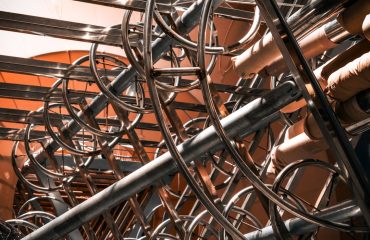body { font-family: sans-serif; line-height: 1.6; }
h1, h2, h3 { color: #333; }
img { max-width: 100%; height: auto; }
The construction of modern ports demands innovative and robust solutions to handle increasing cargo volumes and withstand harsh marine environments. Steel pipes, with their inherent strength, versatility, and cost-effectiveness, are emerging as a game-changer in this field. This article delves into the multifaceted role of steel pipes in port construction, exploring their design, advantages, challenges, environmental impact, and future prospects.
Design Considerations for Steel Pipe Port Structures
The design of steel pipe structures for ports requires meticulous planning and engineering expertise. Factors to consider include the intended use (e.g., jetties, breakwaters, piers), the environmental conditions (e.g., wave action, currents, soil type), and the anticipated load capacity. Detailed analysis using finite element methods is crucial to ensure structural integrity. The design process also involves selecting appropriate pipe diameters, wall thicknesses, and connection methods. Different pipe configurations, such as piles driven directly into the seabed or cased piles, may be employed depending on the site-specific conditions. Furthermore, corrosion protection is a critical aspect of the design, often involving coatings, cathodic protection systems, or the use of corrosion-resistant steel alloys.
Advantages of Utilizing Steel Pipes in Port Construction
Steel pipes offer several advantages compared to traditional construction materials like concrete or timber. Their high strength-to-weight ratio allows for the construction of longer spans and deeper foundations, reducing the overall number of supports needed. This translates to cost savings and expedited construction timelines. Steel pipes are also highly durable and resistant to impact loads, making them ideal for withstanding the harsh conditions of a marine environment. Their prefabrication capability allows for efficient on-site assembly, minimizing disruption and maximizing productivity. Moreover, steel pipes are readily available and relatively inexpensive compared to some alternative materials, contributing further to their cost-effectiveness.
Challenges and Mitigation Strategies in Steel Pipe Port Construction
Despite the numerous advantages, challenges exist in utilizing steel pipes for port construction. Corrosion is a major concern, requiring careful selection of materials and implementation of robust corrosion protection measures. The potential for scour around the pipe foundations needs to be addressed through appropriate design and construction techniques, such as rock berms or scour protection mats. Transportation and handling of large-diameter steel pipes can also pose logistical challenges, requiring specialized equipment and expertise. Effective quality control throughout the entire process, from material selection to installation, is crucial to ensure the long-term performance and safety of the structure. Furthermore, proper planning and environmental impact assessments are vital to mitigate potential negative effects on marine ecosystems.
Environmental Considerations and Sustainable Practices
Environmental concerns are increasingly important in port construction. The use of steel pipes can contribute to sustainable practices through several aspects. Steel is a recyclable material, reducing waste and minimizing the environmental footprint compared to non-renewable materials. Careful planning and design can minimize the disruption of marine habitats during construction. Implementing appropriate measures to prevent pollution during construction and operation is also crucial. The selection of environmentally friendly coatings and corrosion protection systems can further reduce the environmental impact. Life cycle assessments (LCA) can provide a comprehensive evaluation of the environmental performance of steel pipe port structures, allowing for informed decision-making and optimization of sustainable practices.
Future Trends and Innovations in Steel Pipe Port Construction
The field of steel pipe port construction is constantly evolving. Innovations in materials science are leading to the development of high-strength, corrosion-resistant steel alloys, enhancing the durability and longevity of port structures. Advances in design and construction techniques, including the use of advanced modeling and simulation tools, are improving efficiency and reducing costs. The integration of smart technologies, such as sensors and monitoring systems, allows for real-time assessment of structural health and performance, enabling proactive maintenance and reducing the risk of failures. Furthermore, research is underway to explore the use of recycled steel in port construction, promoting circular economy principles and reducing the demand for virgin materials.
In conclusion, steel pipes offer a compelling solution for modern port construction, providing a balance of strength, durability, cost-effectiveness, and sustainability. Addressing the challenges through careful planning, advanced design techniques, and robust construction practices will ensure the continued success and widespread adoption of this innovative approach to port infrastructure development.
SEO Tags:
- Steel pipe port construction
- Port infrastructure
- Marine construction
- Steel pipe applications
- Sustainable port development




